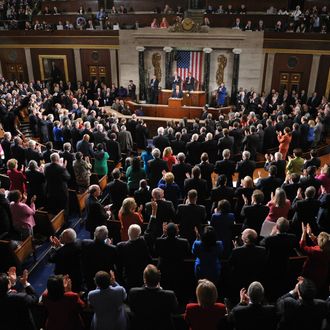
Tonight, President Obama will stand up before a joint session of Congress and try to give his State of the Union address, despite 253 Democratic lawmakers interrupting him just about every other word with standing ovations. Republicans, meanwhile, will mostly sit stone-faced, breaking their synchronized silence at the occasional mention of our brave men and women in uniform or the primacy of America among the nations of the world. No matter how you slice it, there is a mind-boggling amount of applause during State of the Union speeches. Former Republican Senator and Texas Governor Kay Bailey Hutchison told CNN’s aptly named State of the Union this weekend that she’s glad she no longer has “to stand up and clap every fifteen seconds.”
“I just wish so much that we would have a moratorium on standing and let everybody listen,” she added.
So when did the State of the Union morph into a partisan pep rally?
The constitutionally mandated report to Congress has been given in person since Woodrow Wilson’s speech in 1913, has been on television since Harry S. Truman spoke in 1947, and has been in prime time since Lyndon Johnson’s 1966 address. With the additional publicity has come extra clapping: Eisenhower and Kennedy averaged between 30 and 40 applause breaks — less than half the number of the last few White House inhabitants.
But just as significant as the amount of clapping has been an increase in its partisan tenor, which didn’t emerge until the eighties. Before then, “both political parties were internally divided and each party had a liberal and a conservative wing,” Senate historian Donald Ritchie told Daily Intelligencer. “So if a president made a conservative pitch he was appealing to conservatives in both parties and if he made a liberal pitch he was appealing to the liberals in both parties.” By the time of the Reagan administration, “the cheering squad started up.”
In 1982, Democratic congressman Dennis Eckart of Ohio was so intrigued by the “over-the-top” synchronized cheering from Republicans that he went across the aisle and picked up a copy of Reagan’s remarks. They differed in one key respect from the remarks distributed to Democrats: Specific applause cues were peppered throughout. So the next year, Democratic House Speaker Tip O’Neill acquired an early copy of Reagan’s text and decided that Democrats would all cheer at the vaguely pro-government sentiment that “we who are in government must take the lead in restoring the economy.”
National Journal’s George E. Condon Jr. writes that Reagan was flustered but “quickly recovered and shot back, ‘And here all that time, I thought you were reading the paper.’ It was the Republicans’ turn to roar and applaud their leader’s witty riposte. From that moment, the State of the Union address was changed forever. Duelling standing ovations, often triggered by the most banal comment, were here to stay.”
Five years later, William Safire wrote an obituary for the State of the Union in the Times:
In the past, this constitutionally mandated report was the President’s show. […] No more. The presence of the people [via television cameras] in our great hall of the people has transmogrified the event from dutiful report and respectful hearing into a clash between branches of government.
Since 1991, there’s been an average of around 80 applause lines in State of the Union addresses, as calculated from news reports and the number of applause breaks built into the official remarks. Democrats are now the worst offenders: The most applause interruptions on record is 128 times during Bill Clinton’s nearly one-and-a-half-hour 2000 speech, and he and Obama average about 90 applause lines each, compared with fewer than 70 for George Bush and his son.
Sadly, Kay Bailey Hutchison’s desperate plea for quiet and decorum on the floor of the House of Representatives tonight will surely go unheeded, even by those members of Congress who’d rather avoid an hour of strenuous standing ovations. “It’s like being in the ballpark,” explained Senate historian Ritchie. “Whenever everybody else is standing up and cheering, members just have to go with it.”





























